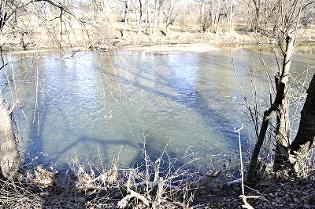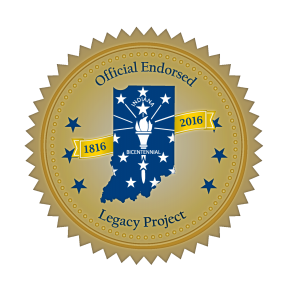IF THE RIVER COULD TALK
RIVER FORDS
Little Boxes On the Riverside
Ford was a "town" of container houses
The ford provided a way for area residents on both sides of the river to cross back and forth between the town and the area that later became Park Place. After crossing the river, travelers would make their way to what today is East 10th Street, which was the area's main east-west road on the river's east side.
If the river could talk, it would tell of an area near Anderson with the curious name of Boxtown. In the 1890s, this same, impromptu community was located along the river's left bank, immediately southeast of the city. It was clustered near the site of the ford, thus giving the ford its name.

This is the view where Prospect Street ends at White River. It is believed to be the location of the Boxtown Ford.
Home of Boxes
What To Read Next
It was called Boxtown because nearly all the houses were built of dry goods boxes procured from the different stores around town. Some of the more dignified or important ones were made of piano cases and were papered on the inside. Outside they were surrounded with grass plots and shrubs of various kinds.
The area was populated by "roughs," most of whom were itinerants, tramps, and bums who regularly caused trouble in that locality. A police report of an investigation there in March, 1896, found that more than 25 people, males and females, lived in two huts. The windows were broken out and the openings were enclosed by rough boards nailed over them. One resident was well known in the Anderson downtown area for years. He was a rag-picker who bore the title of "Bluebeard, the Mayor of Boxtown."
He spent his days roaming the streets of downtown Anderson searching for discarded items that could be converted to something useful. He collected scraps of cloth and paper that could be turned into cardboard or pieces of broken glass that could be melted down and reused. Even dead animals could be skinned to make clothes. Everything would be sold, by weight, to an investor with the means to convert the materials into something profitable.
Everything that Bluebeard collected was loaded into a two-wheel cart having a pair of shafts, between which stood his wife. Much like a horse, she pulled the vehicle while he picked items from the gutters and sidewalks. Each morning, he readied the cart for his daily rounds and then ordered his wife to stand between the shafts; it was said she stepped in with no back talk.
In their March, 1896 report, police investigators described the interior of the place the couple called home. The middle room was filled with smoke coming from a rusty old stove without a pipe. His wife sat on the floor in front of the stove with a clay pipe in her mouth, fanning the fire. In the corner was an old dilapidated bedstead. In another area was nearly a wagon load of filthy, greasy rags.
As the Boxtown area began to develop and improve, the squatters left. Some 15 years later, another group of squatters made the river bank their home. This time it was a group of gypsies who encamped near another of the river's fords. But, that's another story for another time.
Conner Trail
Beginning in the late 1700s, a trail known to history as the Conner Trail became an important "highway" linking John Conner's trading post south of present-day Brookville, Indiana, to his broth William's trading post south of present-day Noblesville. The trail divided a little north of present-day New Castle into two forks. One of the forks of the trail continued in a northerly direction passing through the Delaware Indian village of Wapekommekoke near Muncie. Known as the Indian Road, it made its way along the river's right bank until it reached the crossing point down river from the Boxtown Ford. After crossing the river it re-joined the main Conner Trail, which had continued from the split in a northwesterly direction until it met up with the Indian Road at present-day Anderson.
Continuing downriver, the next crossing point was where the river makes a sharp turn at the base of the high embankment beneath the intersection of Alexandria Pike and Grand Avenue. If the river could talk, If the river could talk, it would say this was a suitable crossing for people on foot, but only during periods of low water or when the river was frozen over sufficiently to carry their weight. Travelers coming and going from Anderson used this crossing site only as a convenience when conditions made it usable. The steep embankment posed a serious problem for travelers not on foot. As a result, most chose to use the Boxtown Ford.
The other ford vital to this area was the Fair Ground Road Ford, and the fifth one in the sequence. The Fair Grounds Road Ford, which is today's Madison Avenue, was named because it formed the western boundary of the Madison County Joint-Stock Agricultural Society fairgrounds located approximately a quarter-mile south of the river.
The ford was used by fair goers who lived north of the river from 1868-1890. It was used extensively during the fall of 1861 by Civil War Union Army recruits who crossed the river from the south en route to the Camp Stilwell instruction camp on the grounds now occupied by the Anderson Country Club.
Stephen T. Jackson, Madison County Historian

Throughout Indiana's Bicentennial year of 2016, Steve Jackson, Madison County Historian, will be authoring "If The River Could Talk." This series will feature people, places, and events that takes place in and around White River.
The series is an officially endorsed legacy project of the Indiana Bicentennial Commission.
Madison County Historical Society|15 West 11th Street, P. O. Box 696, Anderson, Indiana 46015-0696|(765)683-0052|madisonchs10@gmail.com